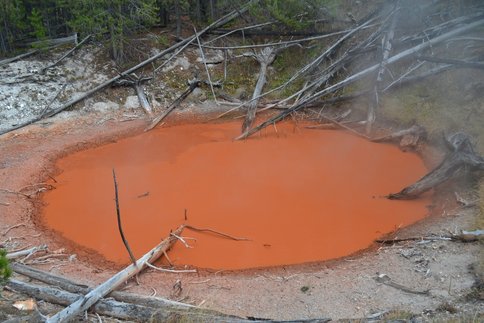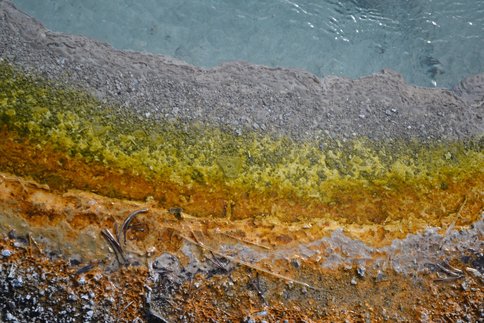2015 Annual Science Report
 University of Colorado, Boulder
Reporting | JAN 2015 – DEC 2015
University of Colorado, Boulder
Reporting | JAN 2015 – DEC 2015
High Temperature W/R Hosted Microbial Ecosystems in Yellowstone
Project Summary
Geochemical data indicate that life on early Earth was dependent on chemical forms of energy. This attribute, when coupled with phylogenetic data indicating that early evolving forms of life were thermophilic, lead many astrobiologists to believe that life evolved in a high temperature environment and was dependent on chemical forms of energy to sustain its metabolism.
Hydrothermal environments with temperatures >70ᵒC exclude life dependent on light energy, leaving only those life forms that can sustain themselves using chemical energy. The >14,000 hot springs in Yellowstone National Park therefore provide a unique field-based early Earth analog environment to examine the processes that sustain life dependent on chemical energy and to investigate the metabolic processes that sustain this life. Moreover, the chemical and physical variation present in these environments affords the opportunity to examine how this variation drove the diversification of life in these early Earth analog environments. RPL investigations in hot spring environments in Yellowstone in 2015 centered on answering questions related to the array of energy and carbon sources available to chemosynthetic life, the preferred carbon sources supporting this life, and the role of hydrogen transformation in the metabolisms of these organisms. By answering these interrelated questions, we will provide a framework by which we can use to begin to understand the processes that most likely sustained microbial life on the early Earth. Since it is possible, if not likely, that such processes would also sustain early life on other planetary bodies, this research has the potential to guide the search for life in non-Earth environments.
Project Progress
Significant debate exists as to whether early forms of life on Earth were autotrophic or heterotrophic. This debate extends to early earth analog hot spring environments, where most scientists assume chemotrophic communities to be largely supported by autotrophic metabolisms. However, evidence to support this claim is minimal. To further evaluate the carbon metabolism of chemotrophic communities we undertook a study aimed at determining the preference for autotrophic or heterotrophic metabolism in populations inhabiting high temperature hot springs. Formate and acetate were selected to represent simple forms of organic carbon that could potentially be generated on an early Earth via abiotic water-rock interactions and which could be readily integrated into the metabolisms of early heterotrophs. Rates of formate and acetate assimilation were compared to rates of dissolved inorganic carbon assimilation (DIC) in 13 high temperature (>73°C) hot springs in Yellowstone National Park (YNP). While 9 of the hot spring communities exhibited rates of DIC assimilation that were greater than that of formate and acetate, 2 exhibited rates of formate and/or acetate assimilation that exceeded that of DIC assimilation providing evidence that not all chemosynthetic communities are supported by autotrophic carbon metabolisms. Overall rates of DIC, formate, and acetate transformation were positively correlated with spring pH but showed little correlation with temperature. Communities sampled from hot springs with similar geochemistry generally exhibited similar rates of substrate transformation. This is consistent with similar community compositions in springs with similar geochemistry as revealed by 16S rRNA gene tagged sequencing. Amendment of microcosms with low (µM) amounts of formate suppressed DIC assimilation and the concentration of added formate required to suppress DIC assimilation was similar to the affinity constant (Km) for formate transformation as determined by community kinetic assays. These results suggest that dominant chemoautotrophs in high temperature communities are facultatively autotrophic, adapted to fluctuating nutrient availabilities, and are capable of taking advantage of energy-rich organic substrates when they become available.
Chemoautotrophic life is sustained by inorganic sources of electron donors and acceptors. Previous studies have suggested a central role for hydrogen metabolism in supporting high temperature hot spring communities. To further evaluate this hypothesis we characterized rates of hydrogen transformation in eleven chemosynthetic communities inhabiting hot springs that were located in regions of Yellowstone with differing subsurface bedrock. In addition, we quantified rates of autotrophic and heterotrophic metabolism (formate and acetate), and collected samples for RNA-based characterization. To provide context for the community composition and metabolic activity measurements, we determined in situ concentrations of a suite of potential microbial substrates including hydrogen, carbon monoxide, low molecular weight organic acids, as well as a range of electron acceptors. These measurements provide a basis for comparing (a) the substrate-specific kinetic (enzyme uptake) data against naturally occurring concentrations of those same substrates; and (b) the landscape of energy availability in various metabolic processes, determined as both molar Gibbs energy change and as metabolic power generation potential, against the observed distribution of metabolic activity across a range of physical and chemical variables. Preliminary results indicate substantial rates of hydrogen transformation that are correlated with high rates of primary production. These findings are consistent with the conclusions of the aforementioned study indicating that hot spring communities are supported primarily by carbon introduced through autotrophic metabolism and this metabolism may be fueled by hydrogen.
Publications
-
Urschel, M. R., Kubo, M. D., Hoehler, T. M., Peters, J. W., & Boyd, E. S. (2015). Carbon Source Preference in Chemosynthetic Hot Spring Communities. Appl. Environ. Microbiol., 81(11), 3834–3847. doi:10.1128/aem.00511-15
-
Zadvornyy, O. A., Boyd, E. S., Posewitz, M. C., Zorin, N. A., & Peters, J. W. (2015). Biochemical and Structural Characterization of Enolase from Chloroflexus aurantiacus: Evidence for a Thermophilic Origin. Frontiers in Bioengineering and Biotechnology, 3. doi:10.3389/fbioe.2015.00074
-
PROJECT INVESTIGATORS:
-
PROJECT MEMBERS:
Tori Hoehler
Co-Investigator
Eric Roden
Co-Investigator
Everett Shock
Co-Investigator
John Spear
Co-Investigator
Maximiliano Amenabar
Collaborator
Dan Colman
Collaborator
Kristen Fristad
Collaborator
Melody Lindsay
Collaborator
-
RELATED OBJECTIVES:
Objective 3.2
Origins and evolution of functional biomolecules
Objective 3.3
Origins of energy transduction
Objective 4.1
Earth's early biosphere.
Objective 5.2
Co-evolution of microbial communities
Objective 5.3
Biochemical adaptation to extreme environments
Objective 6.1
Effects of environmental changes on microbial ecosystems


